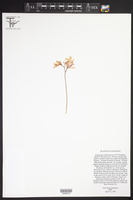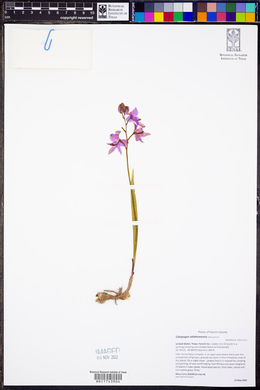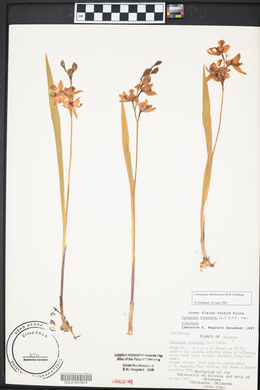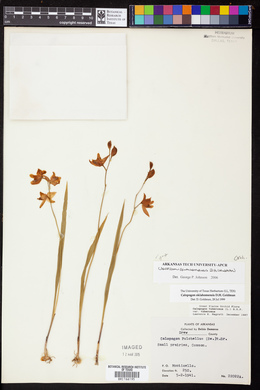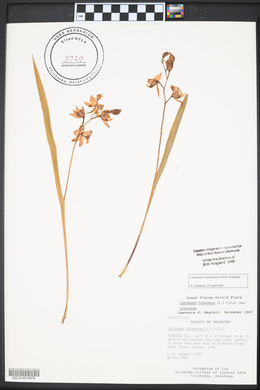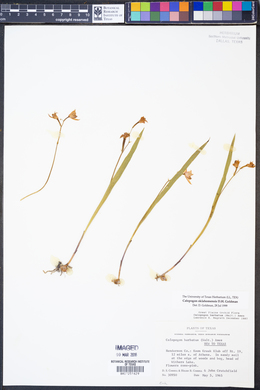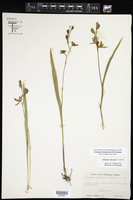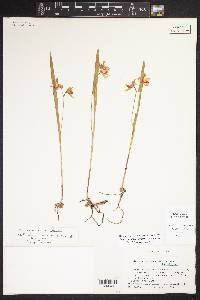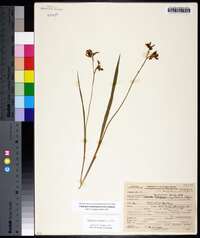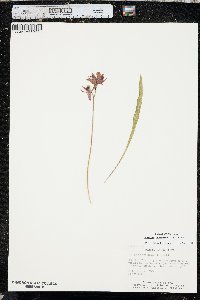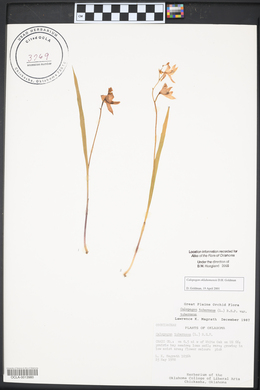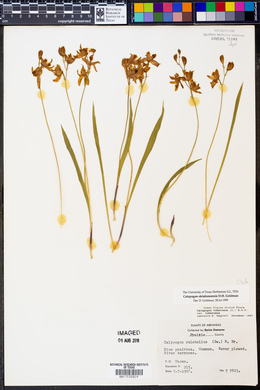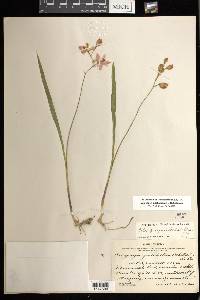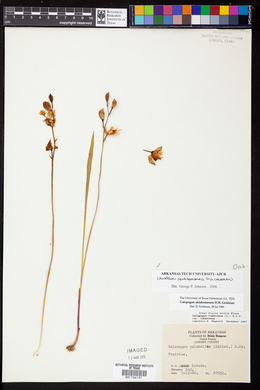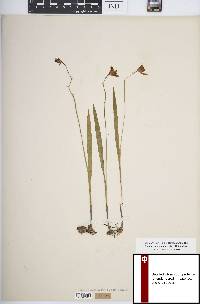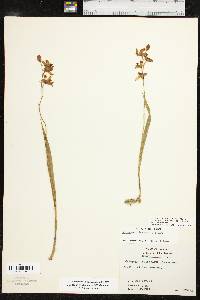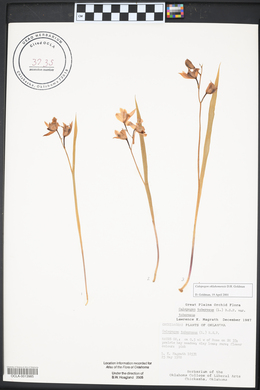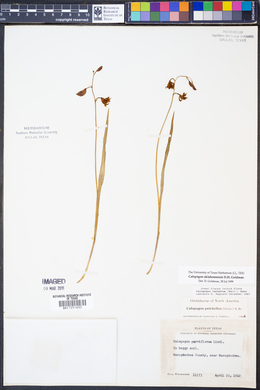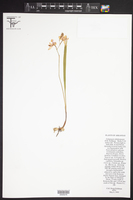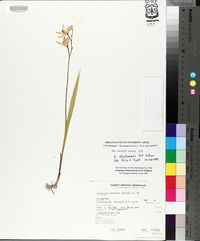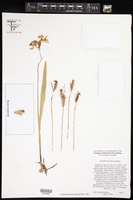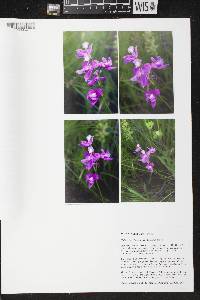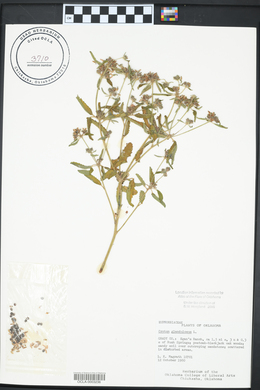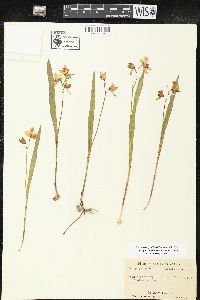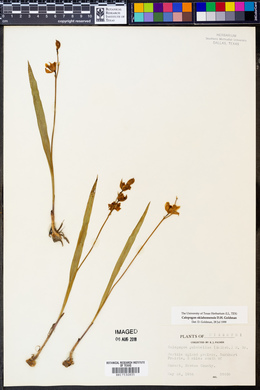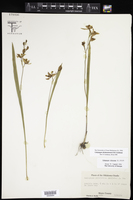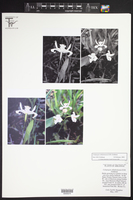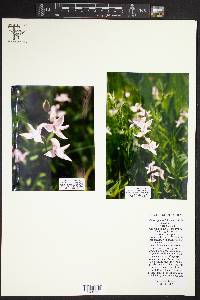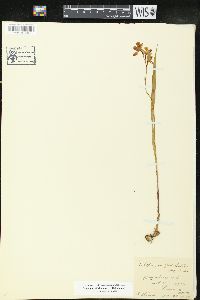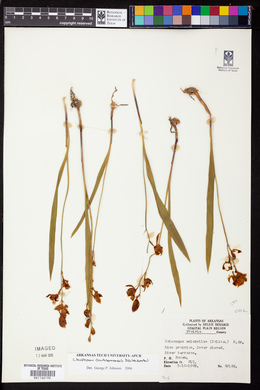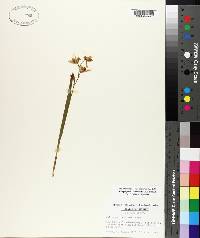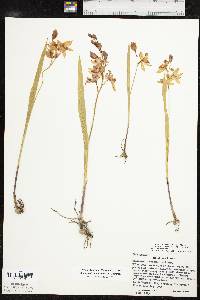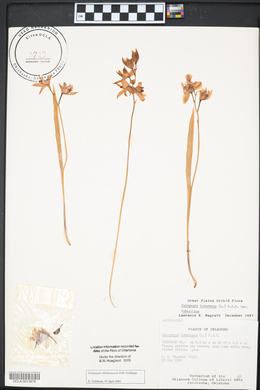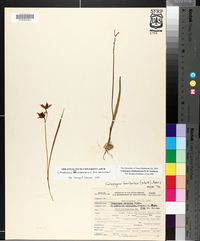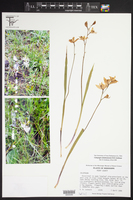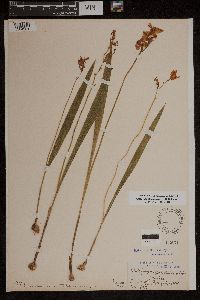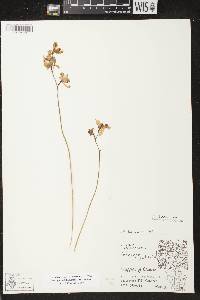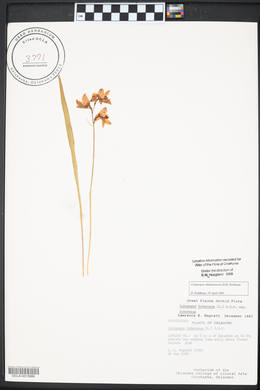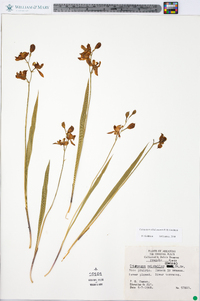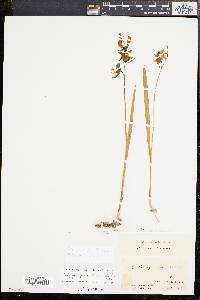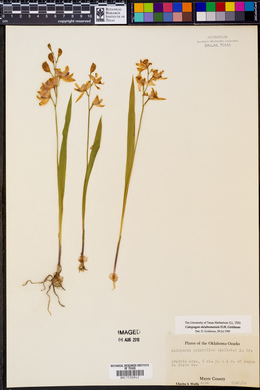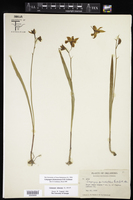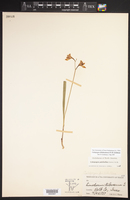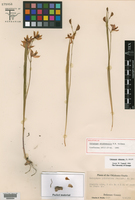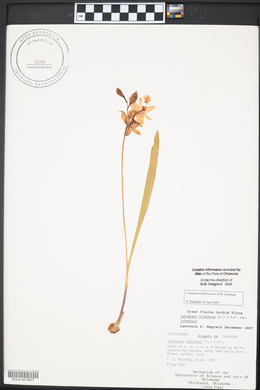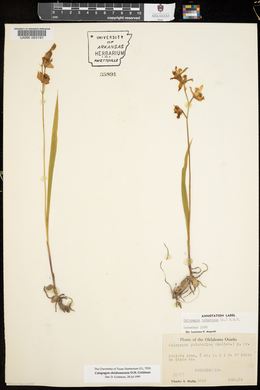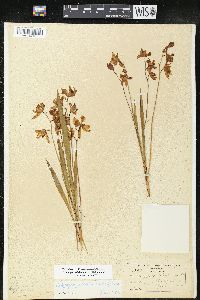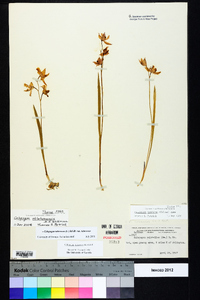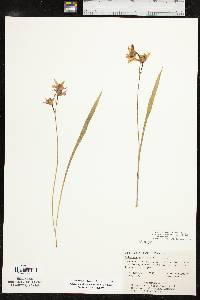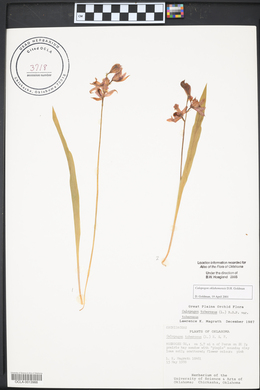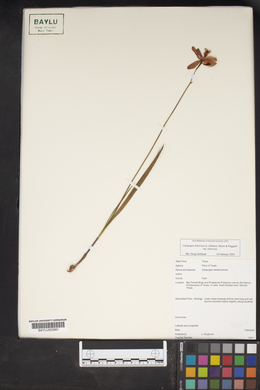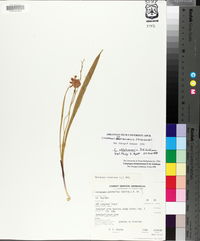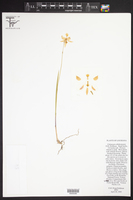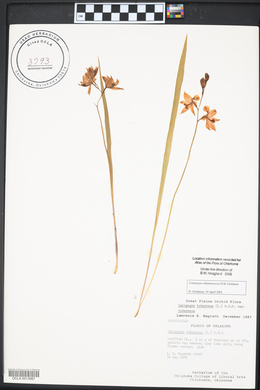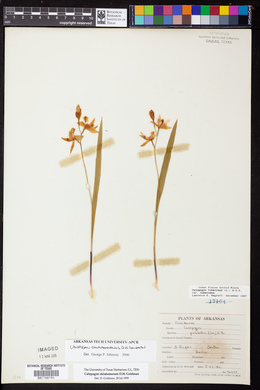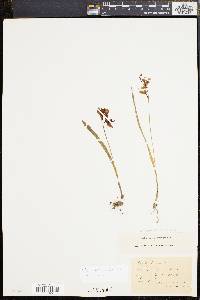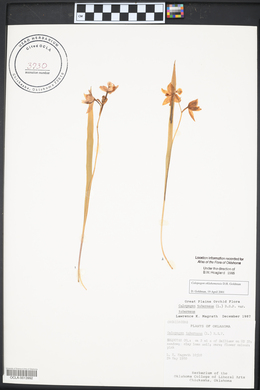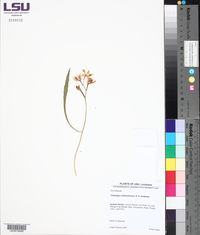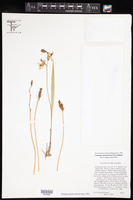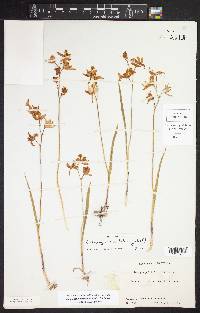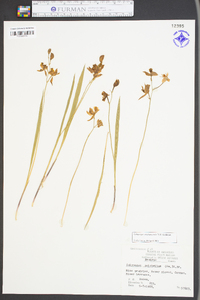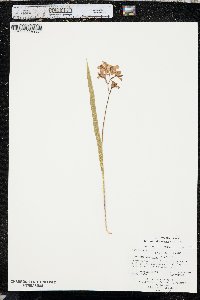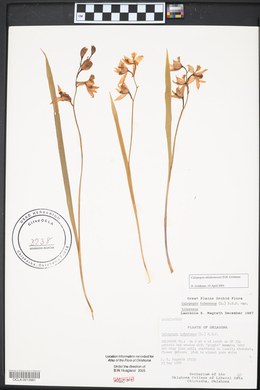
|
|
|
|
Family: Orchidaceae
Oklahoma Grass-Pink, more...Oklahoma grasspink
|
Plants 11-35 cm. Corms elongate, forked, 18-29 mm. Leaves not appressed to inflorescences at flowering; blade linear-lanceolate, 7-35 cm × 5-15 mm. Inflorescences green, 11.8-34 cm; floral bracts ovate-lanceolate to subulate, 3-8 mm. Flowers 2-7(-11), more than 1 cm apart, opening nearly simultaneously, magenta, pink, to white, fragrant; dorsal sepal strongly spreading to straight, obovate to oblanceolate, 14-25 × 5-8 mm, apex acuminate or acute; lateral sepals strongly spreading to straight, ovate to broadly lanceolate, slightly falcate, 15-22 × 8-10 mm, apex acuminate to apiculate; petals slightly falcate to straight, oblong to obpandurate, 11-20 × 5-8 mm, apex obtuse; lip 10-17 mm, middle lobe with dilated apex triangular, broadly rounded, 5-12 mm wide, apex acute or retuse; column 8.5-13 × 1.5-2 mm, distal end 5-8.5 mm wide; rostellum present; stigma typically flat against column surface. 2n = 120. Flowering Mar--Jul. Mesic, acidic, sandy to loamy prairies, pine savannas, oak woodlands, edges of bogs, and frequently mowed meadows; 0--300 m; Ala., Ark., Ga., Ill., Ind., Iowa, Kans., La., Minn., Miss., Mo., Okla., S.C., Tenn., Tex., Wis. Calopogon oklahomensis originally was thought to be restricted to the south-central states; it is much more widespread. It is, however, nearly extirpated outside the south-central states. DNA evidence, as well as its hexaploid chromosome number, suggest that this species may be an alloploid, possibly derived from ancient hybridization between C. barbatus and C. tuberosus (D. H. Goldman 2000).
Perennial herb 11 - 35 cm tall Inflorescence: a single, erect, terminal, stalked, loose (flowers over 1 cm apart), spike-like cluster of three to eight stalked flowers with each flower subtended by a 3 - 8 mm long, narrow lance-shaped to narrowly awl-shaped bract. The fragrant flowers typically open all at once. Flowers: white to pink or magenta, under 5 cm wide, lacking a spur, bilaterally symmetric with central lip petal erect above lateral sepals and petals, and opposite central sepal. Between the upper positioned lip petal and lower central sepal an obvious, petal-like, winged column (fused reproductive parts of stamens, stigma and style) curves downward and forward. Sepals: three, petal-like, light pink to magenta, 1.4 - 2.5 cm long, 0.5 - 1 cm wide, egg- to lance-shaped with pointed tips. The two lateral sepals, which are positioned above the lateral petals, spread strongly sideways or curve to point more forward, while the lower central sepal points straight downward or points slightly forward. Petals: three, light pink to magenta, with central lip erect and nearly perpendicular to two lower petals, which flank the extended, petal-like column. The 1 - 1.7 cm long abnormal positioned lip (on other orchids typically below lateral petals) has two obscure lateral lobes near its base, a narrow central longer lobe covered with lines of distinctive yellow- or orange-tipped club-shaped bristles, and ends in a triangular (longer than wide) yet broadly rounded, 0.5 - 1.2 cm wide tip. Two lower lateral petals oblong, blunt-tipped, 1.1 - 2 cm long, 0.5 - 0.8 cm wide, facing forward or somewhat spreading, with straight or slightly upward curved tips. Fruit: several, erect, more or less stalkless, inversely egg-shaped capsules with three raised lengthwise ridges at the angles, and remnant parts of the column appearing as a hooked beak. Flowering stem: single, erect, entirely green, hairless, lacking leaves, but with one to several tubular sheaths. This leafless structure terminated by flowers is called a scape and technically is not a true stem. Root system: of slender, fibrous true roots attached to a 1.8 - 2.9 cm long, tuberous, elongate, forked structure (corm, technically a shoot or stem). Leaf: usually one, basal, stalkless, grasslike, 7 - 35 cm long, 0.5 - 1.5 cm wide, and linear-lance-shaped. Column: petal-like, pointing down but curving forward, 0.8 - 1.3 cm long, 1.5 - 2 mm wide before greatly expanded tip (0.5 - 0.9 cm wide). The obvious nature of the column allows for easy view of the stigma, which tends to be flat against the surface of the column. Similar species: Believed now to be extirpated in our area, Calopogon oklahomensis is most similar to Calopogon tuberosus. That species can be distinguished by its more globose or rounded corms that never fork, flowers that tend to open sequentially rather than all at once, the expanded tip of the central lobe of the flower lip being wider than long and more anvil-shaped, and the stigma typically positioned at an angle to the column surface. Flowering: mid-May to late July Habitat and ecology: Very rare, believed extirpated from the Chicago Region (last confirmed collection in 1913), previous occurrences include mesic to wet prairies, meadows, along sloughs, moist sands, and even along the Illinois Central Railroad line. Occurence in the Chicago region: native Notes: This species was only formally named in 1995. It was originally believed to be restricted to the south-central United States, but specimen collections show it had a wider distribution, at least in the past. The species is probably near to extirpation outside of the heart of its range in the south-central states (Goldman et al. 2002). Etymology: Calopogon is derived from the Greek words kalos, meaning beautiful, and pogon, meaning beard, thus the "beautiful beard" refers to the bristle-covered lip. Oklahomensis refers to the state of Oklahoma, which is near the center of the range for this species in the south-central United States. Author: The Field Museum From Flora of Indiana (1940) by Charles C. Deam Indiana Coefficient of Conservatism: C = 10 Wetland Indicator Status: N/A |


